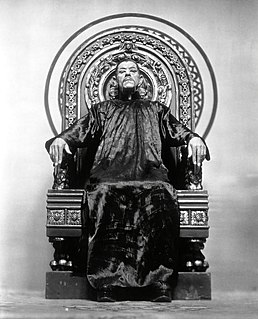
Dr. Fu Manchu is a supervillain who was introduced in a series of novels by the English author Sax Rohmer beginning shortly before World War I and continuing for another forty years. The character featured in cinema, television, radio, comic strips and comic books for over 90 years, and he has also become an archetype of the evil criminal genius and mad scientist, while lending his name to the Fu Manchu moustache.

Arthur Henry "Sarsfield" Ward, better known as Sax Rohmer, was an English novelist. He is best remembered for his series of novels featuring the master criminal Dr. Fu Manchu.

The Yellow Peril is a racial colour-metaphor that depicts the peoples of East and Southeast Asia as an existential danger to the Western world. As a psycho-cultural menace from the Eastern world, fear of the Yellow Peril is racial, not national, a fear derived not from concern with a specific source of danger or from any one people or country, but from a vaguely ominous, existential fear of the faceless, nameless hordes of yellow people. As a form of xenophobia, the Yellow Terror is fear of the Oriental, non-white Other, a racialist fantasy presented in the book The Rising Tide of Color Against White World-Supremacy (1920), by Lothrop Stoddard.

The Big Four is a work of detective fiction by Agatha Christie, first published in the UK by William Collins & Sons on 27 January 1927 and in the US by Dodd, Mead and Company later in the same year. It features Hercule Poirot, Arthur Hastings, and Inspector Japp. The UK edition retailed at seven shillings and sixpence (7/6) and the US edition at $2.00.
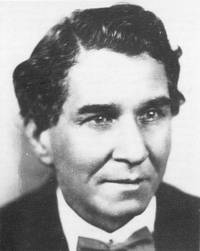
Matthew Phipps Shiell, known as M. P. Shiel, was a British writer. His legal surname remained "Shiell" though he adopted the shorter version as a de facto pen name.

The Fiendish Plot of Dr. Fu Manchu is a 1980 comedy film. It was the final film featuring star Peter Sellers and David Tomlinson. Based on characters created by Sax Rohmer, the film stars Sellers in the dual role of Fu Manchu, a megalomaniacal Chinese evil genius, and English country gentleman detective Nayland Smith.
Denis Nayland Smith is a character who was introduced in the series of novels Dr. Fu Manchu by the English author Sax Rohmer. He is a rival to the villain Dr. Fu Manchu.
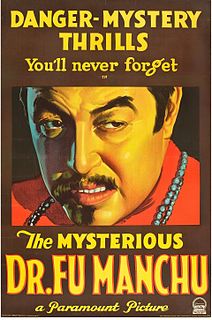
The Mysterious Dr. Fu Manchu is a 1929 American pre-Code drama film directed by Rowland V. Lee and starring Warner Oland as Dr. Fu Manchu. It was the first Fu Manchu film of the talkie era. Since this was during the transition period to sound, a silent version was also released in the United States, although only the sound version exists today. The film's copyright was renewed.
The Yellow Peril is a racist color-metaphor that represents East Asian peoples as an existential danger to the Western world.
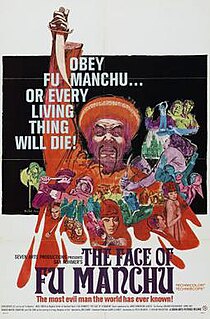
The Face of Fu Manchu is a 1965 thriller film directed by Don Sharp and based on the characters created by Sax Rohmer. It stars Christopher Lee as the eponymous villain, a Chinese criminal mastermind, and Nigel Green as his pursuing rival Nayland Smith, a Scotland Yard detective.
Reflecting the changing political climate, the representation of racial and ethnic minorities in comic books have also evolved over time. This article is intended to document and discuss historical and contemporary racial and ethnic stereotypes in the medium of mainstream comics.

Stereotypes of East and Southeast Asians in the United States refers to ethnic stereotypes of first-generation Asian immigrants as well as Americans with ancestry from East and Southeast Asian countries that are found in American society. Stereotypes of East and Southeast Asians, like other ethnic and racial stereotypes, are often portrayed in the mainstream media, in cinema, in music, on television, in literature, on the internet, as well as in other forms of creative expression in American culture and society. Many of these stereotypes are largely correlative to those that are also found in other core Anglosphere countries, such as in Australia, Canada, New Zealand and the United Kingdom, as mass media are often closely interlinked between these countries.
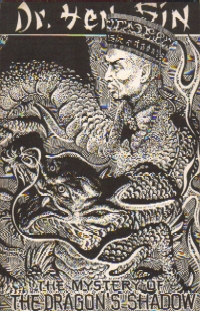
Dr. Yen Sin was a short-lived pulp science fiction magazine published by the New York City-based Popular Publications during 1936. It superseded a similar magazine from the same publishers entitled The Mysterious Wu Fang, which had ceased publication in February 1936. The title characters of both magazines, Wu Fang and Yen Sin, were Yellow Peril villains in the mold of Fu Manchu.

Drums of Fu Manchu (1940) is a 15-chapter Republic serial film based on the character created by Sax Rohmer. Though using the title of the ninth novel in the series, it actually is based on numerous elements from throughout the series to that point, cherry-picked by the writers. It starred Henry Brandon, William Royle and Robert Kellard. It was directed by the legendary serial team of William Witney and John English and is often considered one of the best serial films ever made.

The Mystery of Dr. Fu-Manchu (1913) is the first novel in the Dr. Fu Manchu series by Sax Rohmer. It collates various short stories that were published the preceding year. The novel was also published in the U.S. under the title The Insidious Dr. Fu-Manchu and was adapted into the film The Mysterious Dr. Fu Manchu.
Cay Van Ash was a Professor of English Literature at Waseda University in Japan and a writer.
Sumuru is a female supervillain created by Sax Rohmer, author of the Fu Manchu series of novels. She first appeared in a 1945-1946 BBC radio serial, which was rewritten as a novel in 1950. Four more novels were published between 1951 and 1956. Two movies were then made in the 1960s and one more in 2003.
Harry Agar Lyons was an Irish-born British actor. He was born in Cork, Ireland in 1878 and died in Wandsworth, London, England in 1944 at age 72.

The Mysterious Wu Fang was a pulp magazine which published seven issues in 1935 and 1936. Sax Rohmer's Fu Manchu, an oriental villain, was a "yellow peril" stereotype, and Popular Publications wanted to take advantage of the public's interest. The author of all seven lead novels was Robert J. Hogan, who was simultaneously writing the novels for G-8 and His Battle Aces, producing 130,000 to 150,000 words per month; Hogan was told to not to rewrite, but to deliver his first drafts. The hero of the novels was a man named Val Kildare; other characters included a young assistant to Kildare, who was probably added to attract younger readers. The artist John Richard Flanagan, who had experience illustrating Fu Manchu, was hired, but in the opinion of pulp historian Robert Weinberg, "an imitation was an imitation, and the magazine did not sell well". There were short stories along with the lead novel in each issue, also with a "yellow peril" theme; the authors included Steve Fisher, Frank Gruber, O.B. Meyers, and Frank Beaston. The magazine was cancelled after seven issues in favor of a similar magazine with a different villain: Dr. Yen Sin. According to pulp historian Joseph Lewandowski, the decision to switch titles may have been because Wu Fang was too juvenile, and Dr. Yen Sin was supposed to be more mature.












